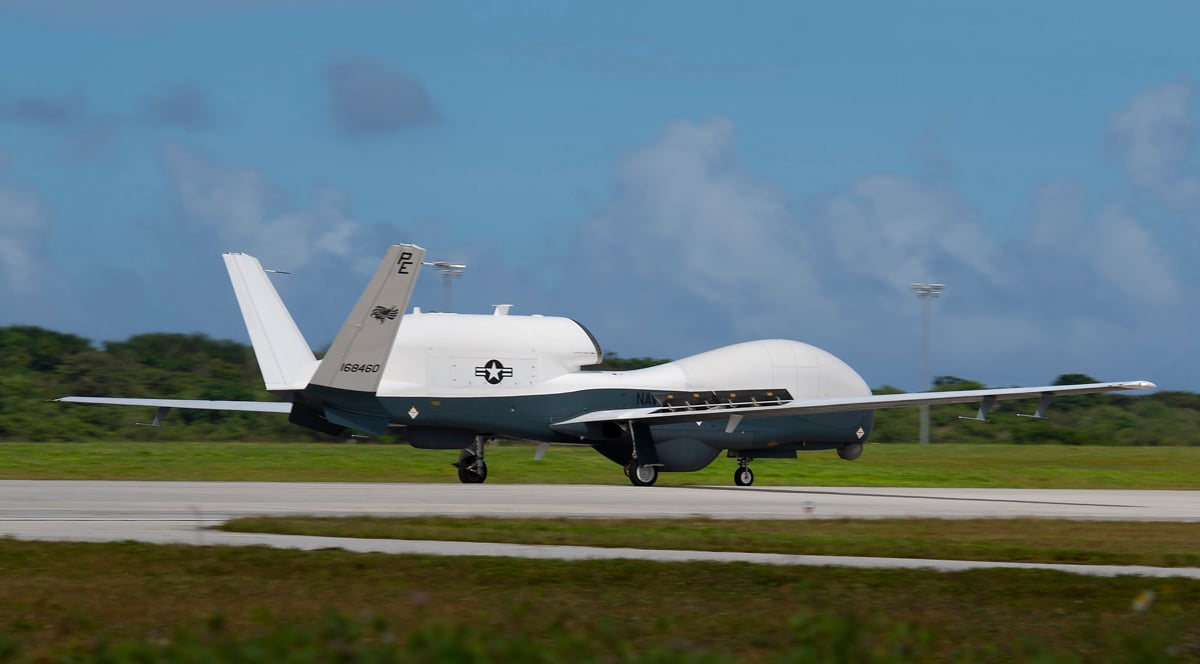Click Here to View This Page on Production Frontend
Click Here to Export Node Content
Click Here to View Printer-Friendly Version (Raw Backend)
Note: front-end display has links to styled print versions.
Content Node ID: 400480
Germany has finally abandoned its plans to acquire four Northrop Grumman MQ-4C Triton UAVs configured for signals intelligence (Sigint) at an estimated cost of $2.5 billion, after the U.S. Navy’s offer for the delivery of Triton aircraft expired in late December 2019. Instead, reports suggest that Germany will now procure three manned Bombardier Global 6000 special-mission aircraft, although no funding has yet been allocated.
Purchase of the Tritons was approved by the U.S. in 2018. The aircraft were intended to fly signals intelligence missions under the Persistent German Airborne Surveillance System (Pegasus) program and were to have been equipped with a Hensoldt ISIS-ZB Sigint sensor system derived from that originally designed by Airbus for the earlier, stillborn RQ-4E Euro Hawk. The same system will now be carried by the new Global 6000s.
It has been reported that the Triton plan had grown “significantly more expensive” compared to German planning assumptions, while there were growing concerns that full European Union Aviation Safety Agency (EASA) certification was going to be difficult to achieve within the required timescale.
Experience with the similar Global Hawks used by NATO’s new Alliance Ground Surveillance fleet, stationed in Sigonella, Sicily, led the German Ministry of Defence to conclude that it was unlikely to be able to meet the safety standards required for flying in European airspace by 2025, and would be subject to onerous restrictions that required it to fly only in segregated airspace and dedicated corridors.
Bandwidth constraints—and the growing problem of GPS and datalink jamming and disruption—may also have influenced Berlin and prompted it to look again at a manned platform with onboard analysis capabilities. It may be no coincidence that no major air force has deployed a UAV platform in the strategic Sigint role.
Production of the Global 6000 is drawing to a close, and Berlin will have to move quickly if it is to obtain the aircraft it requires. The Global 6000 already forms the basis of a dedicated Sigint platform for the UAE Air Force (two aircraft having been converted by Marshall Aerospace in the UK), while Turkey is converting another four to Hava SOJ (stand-off jammer) configuration.
The German Navy began preparing for SLWÜA (Signalerfassende Luftgestützte Weiträumige Überwachung und Aufklärung, signal-recording airborne long-range surveillance and reconnaissance) missions from 1969, on behalf of the German defense ministry, for use as a joint-service asset. The Marineflieger equipped five of its Dassault-Breguet Atlantic maritime patrol aircraft with a modern U.S. Sigint system under the Peace Peek program. The intelligence equipment was fully funded via U.S. Foreign Military Sales channels and was based on that used on the U.S. Air Force’s RC-135 aircraft, undergoing the same upgrades and modernization efforts.
The last of 16 ASW-configured Atlantics were replaced by eight second-hand P-3C Orions between November 2005 and March 2006, purchased from the Royal Netherlands Navy for $355 million. This left the Peace Peek Atlantics as a small and increasingly difficult and costly to support mini-fleet. One was scrapped in 2005, and the last retired in June 2010, leading to what will be a 15-year capability gap.
An initial German attempt to field a Sigint UAV failed when the five-aircraft Euro Hawk program was abandoned in 2013, after about $730 million had been spent, and after forcing the resignation of the then-German defense minister Thomas de Maizière. The RQ-4E Euro Hawk was a modified version of the USAF’s Northrop Grumman RQ-4B Global Hawk high-altitude long-endurance (HALE) UAV, fitted with an Airbus Defence and Space sensor package, but certification and airworthiness issues proved insoluble.
A single prototype was handed over, and some infrastructure work was completed at the proposed base at Schleswig-Jagel, before the program was abandoned. Germany subsequently turned its attention to the U.S. Navy MQ-4C Triton variant, previously known as the RQ-4N, which has now also been canceled.
